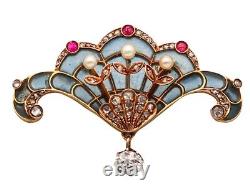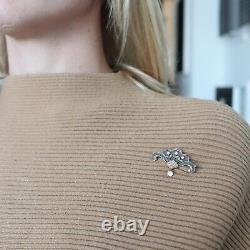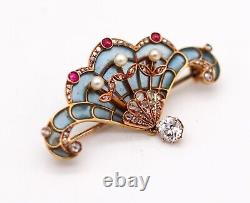Art Nouveau 1890 Plique à Jour Pendant Brooch In 18Kt Gold Diamonds Pearls Ruby







A exceptional piece, created during the. Period, back in the 1890.
Surely It was crafted in Austria or Germany with the difficult enamelling technique of the. Over yellow gold of 18 karats. Fitted at the reverse, with a hinged stem pin bar and a security hook. The work in the section of the.Is magnificent, with a beautiful workmanship and attention to detail that really make this piece stand out. It is definitely a piece of great artistic value that brings together all the elements of the art nouveau style.
This would be a great addition to a jewelry collection from this period. Diamonds : Mount in a hanging eight-prongs setting, with 1 European rose cut diamond of 0.50 carats, white colorless F color, VS/SI clarity.
Diamonds : Mount with mixed 52 old European rose cut diamonds, 0.78 carats, G color, VS/SI clarity. Rubies : Bezel set, with 3 round cut red rubies, 0.18 carats. Pearls : Accented with 3 graduated round white pearls. Birthstone : Rubies, for the month of September. Weight : 6.85 Grams, (4.39 Dwt).Measurements : 42 mm by 28 mm (1.65 x 1.10 Inches). Hallmarks : No marks, tested for 18 kt gold. Jewelry was created in France between about 1895 and 1910, coming on the heels of the "overwrought" designs of the Victorian era (which ended with Queen Victoria's death in 1901) and creating a striking contrast to the mainstream Edwardian designs of that time. While jewelry with a similar aesthetic was being made in other countries during the same time period--for example, Jugendstil in Germany and Austria--true Art Nouveau jewelry is decidedly extended in France.
It was a short-lived period in jewelry design, lasting only about 15 years, because of the onset of World War I and because the pieces were so over-the-top that people quickly lost interest in them. Characterised by lavish and organic ornamentation, the Art Nouveau movement blossomed in Vienna at the turn of the 20th Century, with influential Austrians architects Otto Wagner and Adolf Loos making significant architectural contributions that helped shape the city's skyline as we see it today. Rene Lalique, was the most celebrated art nouveau designer, championed jewelry designer.Note : The Vienna Secession work is often referred to (during the years before World War I) as the Austrian version of Jugendstil, the German term for Art Nouveau, and it is the work of its members in association with that style that has contributed most to its fame, particularly outside of Austria. Turns out it's the local version of Art Nouveau. So a synonym for that decorative style that makes use of curves, natural forms and ornate motifs along with modern materials. Jugendstil blossomed in Vienna during the late 19th century and early 20th century. From the French is "letting in daylight".
Is a very difficult vitreous enamelling technique where the enamel is applied in cells, similar to cloisonné, but with no backing in the final product, so light can shine through the transparent or translucent enamel. It is in effect a miniature version of stained-glass and is considered very challenging technically: high time consumption (up to 4 months per item), with a high failure rate. The technique is similar to that of cloisonné, but using a temporary backing that after firing is dissolved by acid or rubbed away.
A different technique relies solely on surface tension, for smaller areas. In Japan the technique is known as shotai-jippo (shotai shippo), and is found from the 19th century on. Collateral : It is accompanied by the original antique presentation jewelry box.
Condition : The overall condition of this piece is excellent. Beside the little normal wear, there is no damage to the gold. All gemstones are secured in the settings. This brooch has been carefully inspected to guarantee the condition and authenticity.
This item is in the category "Jewelry & Watches\Vintage & Antique Jewelry\Brooches & Pins". The seller is "treasurefinejewelry" and is located in this country: US.
This item can be shipped to United States.- Antique: Yes
- Number of Diamonds: 52
- Shape: FAN
- Occasion: ANY
- Year Manufactured: Pre-1920
- Main Stone Color: White/Colorless
- Item Length: 1.65 INCHES
- Metal: Yellow Gold
- Secondary Stone: Diamond, Pearl
- Jewelry Department: Fine
- Main Stone: Pearl
- Vintage: Yes
- Main Stone Treatment: NONE
- Department: Women
- Main Stone Shape: Rose Cut
- Base Metal: Gold
- Gemstone Clarity Grade: Eye Clean
- Features: P020823AINM/.1646
- Number of Gemstones: 6
- Handmade: Yes
- Main Stone Creation: Natural
- Seller Warranty: Yes
- Signed: No
- Cut Grade: Excellent
- Color: Multicolor
- Material: GOLD PEARLS DIAMONDS RUBIES AND ENAMEL
- Total Carat Weight: 0.96 CARATS
- Certification: GENUINE PIECE FROM THE PERIOD
- Diamond Clarity Grade: VS/SI
- Setting Style: Flush
- Brand: AUSTRIAN ART NOUVEAU
- Type: Brooch
- Metal Purity: 18k
- Era: Art Nouveau (1895-1910)
- Customized: No
- Diamond Color Grade: F/G/H
- Original/Reproduction: Original
- Theme: PLIQUE A JOUR
- Country/Region of Manufacture: Austria
- Wholesale: No
- Country of Origin: Austria

